AMD FX-8320E CPU Review: The Other 95W Vishera
by Ian Cutress on January 13, 2015 10:00 AM ESTF1 2013
First up is F1 2013 by Codemasters. I am a big Formula 1 fan in my spare time, and nothing makes me happier than carving up the field in a Caterham, waving to the Red Bulls as I drive by (because I play on easy and take shortcuts). F1 2013 uses the EGO Engine, and like other Codemasters games ends up being very playable on old hardware quite easily. In order to beef up the benchmark a bit, we devised the following scenario for the benchmark mode: one lap of Spa-Francorchamps in the heavy wet, the benchmark follows Jenson Button in the McLaren who starts on the grid in 22nd place, with the field made up of 11 Williams cars, 5 Marussia and 5 Caterham in that order. This puts emphasis on the CPU to handle the AI in the wet, and allows for a good amount of overtaking during the automated benchmark. We test at 1920x1080 on Ultra graphical settings.
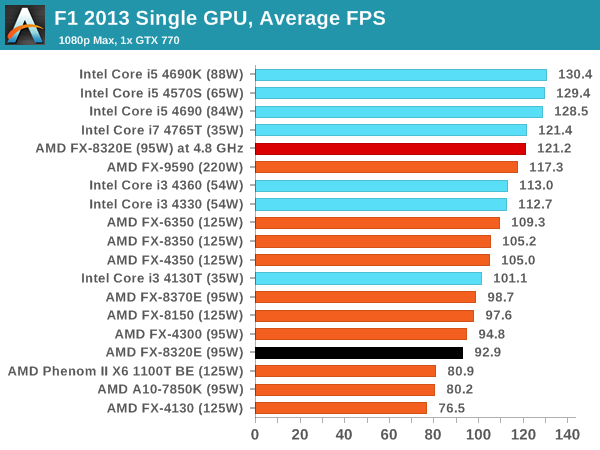
In both single and dual GPU cases, the stock performance of the FX-8320E falls behind the i3 CPUs by a 10-20 FPS margin, perhaps being noticeable on 120 Hz monitors. The minimum FPS on a single GPU still retains above 60 FPS, which is a plus.
Bioshock Infinite
Bioshock Infinite was Zero Punctuation’s Game of the Year for 2013, uses the Unreal Engine 3, and is designed to scale with both cores and graphical prowess. We test the benchmark using the Adrenaline benchmark tool and the Xtreme (1920x1080, Maximum) performance setting, noting down the average frame rates and the minimum frame rates.
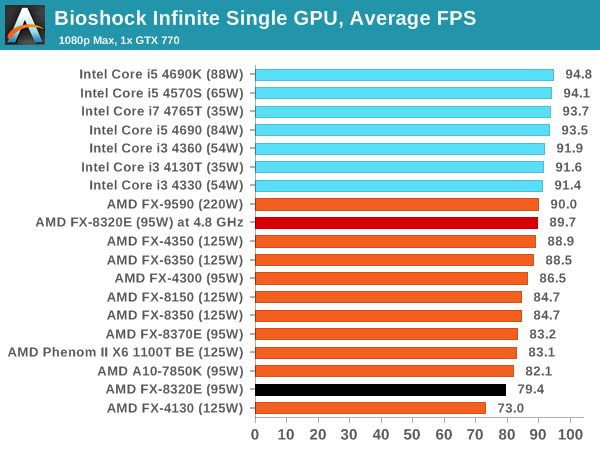
While average frame rates almost appear to be CPU agnostic, there is a clear AMD/Intel split here. More interesting is the minimum FPS results which seem to rely on IPC.
Tomb Raider
The next benchmark in our test is Tomb Raider. Tomb Raider is an AMD optimized game, lauded for its use of TressFX creating dynamic hair to increase the immersion in game. Tomb Raider uses a modified version of the Crystal Engine, and enjoys raw horsepower. We test the benchmark using the Adrenaline benchmark tool and the Xtreme (1920x1080, Maximum) performance setting, noting down the average frame rates and the minimum frame rates.
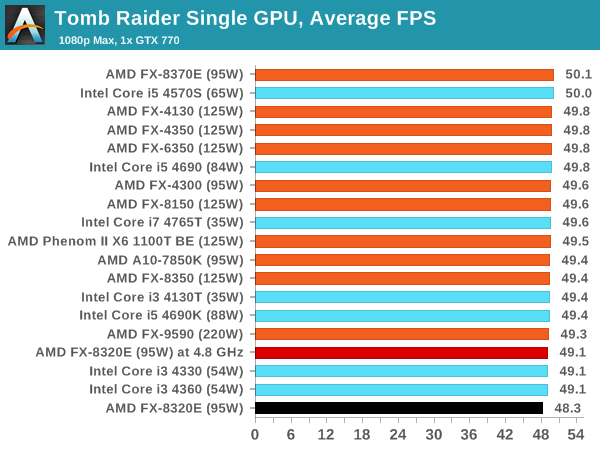
Tomb Raider still comes across as purely CPU agnostic.
Sleeping Dogs
Sleeping Dogs is a benchmarking wet dream – a highly complex benchmark that can bring the toughest setup and high resolutions down into single figures. Having an extreme SSAO setting can do that, but at the right settings Sleeping Dogs is highly playable and enjoyable. We run the basic benchmark program laid out in the Adrenaline benchmark tool, and the Xtreme (1920x1080, Maximum) performance setting, noting down the average frame rates and the minimum frame rates.
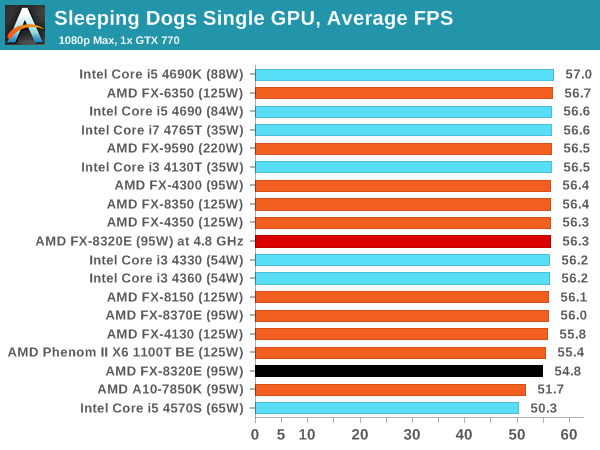
Single GPU usage puts the 8320E in the ballpark, but moving to dual GPUs sees an uplift in terms of the i5 CPUs for high refresh rate screens, albeit with the extra cost associated.
Battlefield 4
The EA/DICE series that has taken countless hours of my life away is back for another iteration, using the Frostbite 3 engine. AMD is also piling its resources into BF4 with the new Mantle API for developers, designed to cut the time required for the CPU to dispatch commands to the graphical sub-system. For our test we use the in-game benchmarking tools and record the frame time for the first ~70 seconds of the Tashgar single player mission, which is an on-rails generation of and rendering of objects and textures. We test at 1920x1080 at Ultra settings.
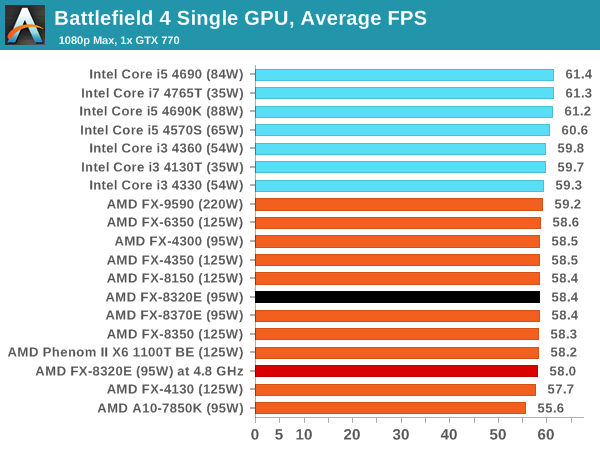
Single GPU shows little difference (despite a clear AMD/Intel separation line), but in dual GPU mode an i3 will make a 17 FPS rise, moving to 27 FPS with the i5 and more relevant to high refresh displays.















92 Comments
View All Comments
Kevin G - Tuesday, January 13, 2015 - link
Updating the chipset is necessary to get new IO on to a platform. Things like USB 3.0 can then be integrated into the chipset so that a 3rd party controller is no longer needed.Rather the nice thing is that AMD hasn't changed socket in 5 years with AM3+. Intlel on the other hand has had three sockets of chips with dual channel DDR3, 16 PCIe lanes and DMI to the chipset. Sure, a few things changed between socket 1156, 1155 and socket 1150, but it would have been nice if Intel was forward thinking and maintained compatibility. The quad core Lynfield chips are still respectable in terms of CPU performance today.
Penti - Tuesday, January 13, 2015 - link
They has basically frozen their whole platform with the failed Bulldozer release. Their chipset's hasn't changed much since AM2+/AM3 days, the NB is basically the same as the 2007 790FX. The only thing 990FX added over 790FX is probably the IOMMU-support (and updated the PCIe lanes used by the SB to PCIe 2.0 also called A-link Express) which was first found in the identical 890FX, also IOMMU was found in server chipsets built on the 800-series back in '10. The southbridge on AM3+ hasn't changed since launch and is basically the same as the 2010 SB850. It's planned that they have a 4 year or so gap. They canceled a lot of designs and plans. Including new server socket and server chipset. They scrapped the plans for new BD chips for AM3+/successor socket also which is why you have no Steamroller or Excavator, and why you have no 10/20-core 2-gen Bulldozer/Piledriver for servers. So the chipset is really 5 years old and based on the same tech as 7 year old NB built on the same process and had HT3 support back then too. So the NB is really 2007-era with minor changes, SB has no USB3 support.Intel basically did have a platform which didn't get a chipset update for ~3 years – the X79. That wasn't such a good deal thanks to no native USB3 support, few SATA6 ports and so on. Lots of bugs too.
stefantalpalaru - Tuesday, January 13, 2015 - link
Here are a series of benchmarks I did on the same (rather modest) motherboard with a Phenom II X6 at 3.9 GHz and the FX-8320E at stock frequency and a 4.5 GHz overclock: http://openbenchmarking.org/result/1412036-KH-MERG...mikato - Wednesday, January 14, 2015 - link
Very cool! Thanks for this. If I interpret the colors correctly, it looks like the X6 wins mostly, but when the FX-8320E is overclocked, it wins mostly.LarsBars - Saturday, January 17, 2015 - link
I used some of the sorting tools and it looks like your summary is correct.But keep in mind that the Phenom II X6 is overclocked... so it's kind of hard to draw conclusions from it. I guess it would have made sense if it was stock vs stock (which we sort of already have in the AT article) or OC vs OC (since AT didn't OC an X6).
$0.02
SpaceRanger - Tuesday, January 13, 2015 - link
The only graph that I wanted to see was the power consumption graph, and it's not included.. :(I really wanted to see just how much they chopped off the power consumption with this go-around.
silverblue - Tuesday, January 13, 2015 - link
Toms benched the 8370E and appeared to get some very interesting power readings. Though this doesn't necessarily ring true for the 8320E, it may be helpful nonetheless:http://www.tomshardware.com/reviews/amd-fx-8370e-c...
sonicmerlin - Tuesday, January 13, 2015 - link
The most painful aspect of AMD's single threaded performance woes is that Intel hasn't even bothered with increasing IPC since Sandy Bridge. AMD needs their new architecture to be a smash hit if they want to avoid bankruptcy.silverblue - Tuesday, January 13, 2015 - link
And that's what bothers me about Carrizo not coming to the desktop. We don't know if that 30% IPC boost is across the board or mainly as a result of FPU gains, but at the very least, Carrizo should bury Phenom II and previous Bulldozer designs, and at least equal Lynnfield/Nehalem, at the same clocks but for far lower power consumption. Still, performance wise, it's not exactly a lofty goal - you'd need more than four cores for that.xenol - Tuesday, January 13, 2015 - link
Software most people use didn't take advantage of Bulldozer because they weren't multi-threaded. It's because software most people use don't take advantage of CPU performance period. Most of the programs in your task manager idle.Modern software is multi-threaded, as in, they have multiple threads. And all the major OSes (Windows, Linux, Mac OS X) schedule at the thread level on any available resource. If they don't take advantage of multiple cores, it's not because they are "single threaded", it's because what they do isn't very taxing for a CPU to do.